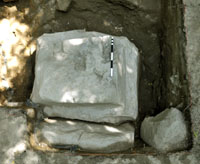You are here
- Home
- Professor Phil Perkins
Professor Phil Perkins
Professional biography
My interest in the Classical world was sparked by an inspiring Latin master and a muddy excavation at Catterick Bridge in North Yorkshire. This led me to the Institute of Archaeology, now part of University College London, where I became involved with archaeological research in Italy. Following graduation, I lived in Italy for the next five years working on research projects, some with the British School at Rome, and teaching at Saint Mary’s College in Rome.
I developed a specialism in Etruscan archaeology researching in the Albegna Valley near the ancient city of Cosa in southern Tuscany. This collaborative work involved extensive multi-period field survey, excavation and artefact analysis. In 1985-6 I co-directed the first ever excavation of an Etruscan farm site at Podere Tartuchino. The excavation revealed two phases of building and uncovered the earliest wine-press yet found in Italy. The farm remains the only Etruscan farm to be both excavated and fully published.
In 1991 I was appointed to the Computers in Teaching Initiative Centre for History with Archaeology and Art History in the University of Glasgow promoting the, at that time, new-fangled use of computers in teaching. This led to a part-time post at the Department of History of Art, Birkbeck College, University of London, teaching on an innovative MA in computing for art historians. At the same time I finished my Ph.D. thesis for the University of London on the Etruscan archaeology of the Albegna Valley.
Meanwhile, in 1992 I co-directed a pioneering post-mediaeval excavation of the Villa Pigneto Sacchetti, a 17th century AD baroque villa in Rome designed by the painter and architect Pietro da Cortona.
I joined the Open University in 1995 and used my experience of educational software, multimedia and image processing in archaeology and art history in developing CD-ROMS for various modules including A103 Introduction to the Humanities and A295 Homer: Poetry and Society. I have contributed to many other modules including A151 Making sense of things: an introduction to material culture, A219 Exploring the classical world. One of the most exciting and challenging teaching projects was writing an online distance learning module, A251 World Archaeology, that covered the whole globe from the last Ice Age to the 19th century CE, taking me a long way in time and space from the Etruscans and Italy. More recently, I authored parts of the MA in Classical Studies, teaching the archaeology of the Colosseum Valley in Rome and bioarchaeological aspects of the ancient body and also various topics on Roman Italy, the Roman economy and Constantine for A340 The Roman empire. For A229 Exploring the classical world, that started in 2018 I wrote tteaching material on the Roman Republic, focussing on the archaeology and history of the city of Rome and Julius Caesar. My most recent teaching project was writing for the new MA in Classical studies on aspects of Classical Archaeology in Asia, the early city of Rome and Pompeii.
Etruscan archaeology remains a focus of my research. During much of 2002 I was seconded to the British Museum and studied some of their Etruscan collection. This led in 2007 to the publication of a definitive study of the Etruscan bucchero ceramics in the British Museum. In the summer of 2007 I joined the Mugello Valley Archaeological Project excavations at the site of Poggio Colla to the north east of Florence in Tuscany. I am studying the bucchero from the excavations and have excavated on the lower slopes of the hill, discovering pottery kilns, textile manufacturing and a stone quarry, related to the temple built on the hilltop. In 2014 I explored the earliest phase of the settlement, excavating an oval timber building. This work is now entering a phase of publication as I research the context of the finds and settlement, extending my research to northern Etruria and the Apennine mountains. In 2016-17 I was awarded the Hugh Last Fellowship at the British School at Rome to continue this research in Italian museums and libraries. In 2018-19 I excavated at Albagino in northern Tuscany at the site of a dried up lake thought to be used in the Etruscan period for votive deposits. In 2023, I returned to field work, joining the Potentino Exploration Project, and investigating the archaeology of an area on the western slopes of Monte Amiata in southern Tuscany.
Alongside this teaching and research I have also been Head of the Department of Classical Studies, Sub-Dean for Research and Associate Dean for Curriculum Development in the Faculty of Arts.
Research interests
Etruscan archaeology
Poggio Colla excavations and artefact studies
Within the broader project exploring the hilltop sactuary and settlement at Poggio Colla I am focusing on the north west hill slope where deposits dating to the Orientalizing Period (about 675-575 BCE) have been investigated. Here we have found rare evidence for economic activity in this early part of the Etruscan period, relating to textile spinning and pottery manufacture. In 2009 we excavated three ‘fire-pits’, probably pottery kilns, and part of a stone quarry, possibly used for the construction of the first temple on the hill top in the mid sixth century. In 2010 we explored these industrial installations further. Details are available online: Poggio Colla 2008 North West Slope project and Final Report. In 2012 a small area was investigated to resolve outstanding stratigraphic questions revealing two further partly-quarried sandstone blocks chiselled from the solid bedrock and roughly shaped, leaving abundant tool marks. A note worthy find was a single sherd of finger-nail impressed Neolithic ceramic of a type known from elsewhere in the lower valley of the Sieve, but this is the first find of Neolithic ceramic from Poggio Colla.

Stamped bucchero bowl and quarried stone.
The aim of the 2013 season was to explore some outcrops of rock, identified in 2012 that showed signs of being worked and to establish the limits of the Etruscan occupation on the hill slope by trial trenching and geophysical survey (magnetometry and ground penetrating radar).Ten trenches were excavated across an area of hill slope c.150 x 50m to assess and sample the archaeological remains.One trench revealed a large rectangular cut in the bedrock with two sequences of steps in the North West corner running down from the present ground level. Tool marks on the cut bedrock were compared with those found in the large Early Modern stone quarry on the South Western side of Poggio Colla and found to be similar, leading to the conclusion that this quarrying activity dates to the 19th century. Nevertheless, undisturbed layers to the West of the cut into the bedrock did preserve an Etruscan occupation layer that yielded late Orientalizing to Early Archaic material similar to that founding earlier seasons. Further test trenches to the west revealed the remains of two dry stone walls and Orientalising and mid-Bronze Age ceramics.
In 2014 excavations on the hilltop exploreed rock-cut features interpreted as post holes, forming part of a wooden structure, perhaps an elliptical hut with a large central post hole and further smaller holes forming an arc – probably the wall of a hut. These is the earliest evidence for structures on the hill top and suggests that a settlement of timber buildings preceded the later temple. In 2015 a final season of excvation revovered one of the longest known Etruscan inscriptions on stone that derives from this first phase of timber structures. Specialist study of the inscription is underway, and it appears to mention the two most important Etruscan deities Tinia and Uni, the equivalents of Roman Jupiter and Juno. Finds from the excavation and a hologram of the inscription went on display in Florence for the Autumn of 2016.

View of the exhibition in the Pinacoteca Regionale Palazzo Panciatichi, Florence.

Hologram of the Etruscan inscription.
Etruscan DNA
In February 2007 there was a flurry of media reports that DNA had been used to prove that the Etruscans originated in Anatolia in modern Turkey. This went against the current archaeological consensus that claims them as an indigenous people in Italy. I decided to investigate…
After an extensive search in new interdisciplinary territory I concluded that the media reports were not quite right and that, as usual, the truth was far more complicated and interesting. You can find out my conclusions at Classics Confidential or YouTube (part 1 and part 2). Part of this research has been published in a paper written in honour of Sybille Haynes.
Perkins, P. (2009) ‘DNA and Etruscan identity’ in Perkins, P. and Swaddling, J. (eds.) Etruscan by Definition, British Museum Press, pp.95-111, ISBN-13: 978-0-86159-173-2.
Bucchero
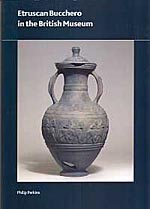 In 2007 I published the results of five years of research into Etruscan Bucchero ceramics in the British Museum. The book provides a history of the study of bucchero and the formation of the Museum's collection. The largest part contains detailed discussion of over 300 ceramic objects, that are contextualized within the past 75 years of scholarship and study of bucchero. All the objects are illustrated. Some of this research was supported Arts and Humanities Research Board, and the book presents a complete catalogue of this distinctive type of pottery in the Greek and Roman Department of the British Museum.
In 2007 I published the results of five years of research into Etruscan Bucchero ceramics in the British Museum. The book provides a history of the study of bucchero and the formation of the Museum's collection. The largest part contains detailed discussion of over 300 ceramic objects, that are contextualized within the past 75 years of scholarship and study of bucchero. All the objects are illustrated. Some of this research was supported Arts and Humanities Research Board, and the book presents a complete catalogue of this distinctive type of pottery in the Greek and Roman Department of the British Museum.
Perkins, P. (2007) Etruscan Bucchero in the British Museum The British Museum Press, London136pp, ISBN 978 0 86159 165 7
You can download it from the British Museum's website.
Whilst working at the British Museum I co-organized with Dr. J. Swaddling the Etruscans Now Conference, a major international conference held at the British Museum in December 2002, and attended by 143 scholars from 13 countries. The conference was supported by The British Academy and the British Museum Friends. Abstracts and draft papers from the international conference are still available on the conference website Etruscans Now. Selected papers have been published in volumes 9 and 10 of Etruscan Studies. A summary of the conference has been published in the periodical Minerva. (Perkins, P. (2003) ‘The inner life of the Etruscans’, Minerva, Vol.14 No.5, 42-3).
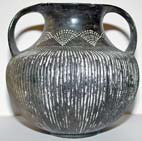
Etruscan bucchero amphora
Field Survey, Excavation and Artefact studies in the Albegna Valley - Ager Cosanus, Tuscany, Italy
Since the early 1980’s I have been involved in archaeological field work in the Albegna Valley in southern Tuscany. This collaborative work with colleagues from Pisa, Siena and elsewhere in the UK and Italy has involved extensive multi-period field survey, excavation and artefact analysis. I have been working with the data relating to the Etruscan period, particularly the ceramic finds and the settlement pattern. Publication of field survey data collected during the 1980’s has involved analysis of Etruscan sites, settlement and burial patterns using GIS to study settlement location and state organization of territory; reconstruction of population change in the region through the first Millennium BC; analysis of Etruscan artefact distributions; and reconstruction of the Etruscan economy.
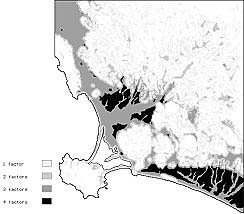
Predictive modelling of the Etruscan settlement pattern in the Albegna Valley
Part of this involves modelling the archaeology of Etruscan communities by analysis of field survey and topographic data with Geographical Information Systems (GIS).
In 1986-6 I direction the first ever excavation of an Etruscan farm site at Podere Tartuchino. The site was discovered by survey as a surface scatter and excavated in order to investigate the sub-surface remains, provide evidence for the economy of small rural sites and to recover stratified ceramic assemblages to date surface scatters. The excavation revealed two phases of building and uncovered the earliest wine-press yet found in Italy. The project was funded by The British School at Rome, the British Academy and other Italian public sources. The award of an Ellaina Macnamara Memorial Scholarship for Etruscan Archaeology enabled the publication of the excavation. The farm remains the only Etruscan farm to be both excavated and fully published.
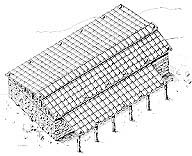
Podere Tartuchino phase 1
Excavation and publication of the Villa Pigneto Sacchetti, Rome
In 1992 I co-directed a pioneering post-medieval excavation of the Villa Pigneto Sacchetti, a 17th century AD baroque villa in Rome in a project with Canterbury School of Architecture and the University of Rome, funded by the British School at Rome and the Carnegie Trust. The Villa Pigneto Sacchetti, built by the painter and architect Pietro da Cortona, was believed lost, but field survey re-located the building and excavation recovered a partial ground plan, enabling a comparison of the physical remains with the surviving eighteenth century architectural drawings and seventeenth century documents. Results were published in the Papers of The British School at Rome.
Subsequently, we revisited the interpretation of the development of the villa in the light of new art historical research on the its decoration, proposing a more complex, phased, building history than previously, once again in the Papers of The British School at Rome.
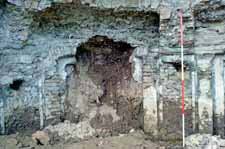
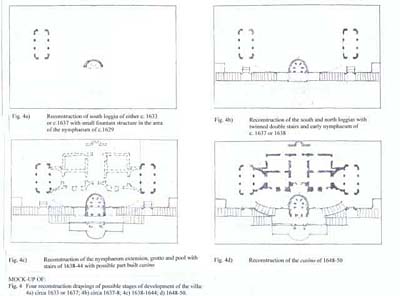
Nymphaeum, Villa Pigneto Sacchetti
Quantitative studies of African Red Slip Ware
I have a long term interest in research into Roman economic and settlement histories through the analysis of the chronological and spatial distribution of African Red Slip ware (1st - 7th century AD). In collaboration with colleagues, quantification of a data set of 20,000+ sherds of African Red Slip Ware from field surveys and other representative finds, charts the frequency of imports of the ware into individual areas across the Mediterranean. Deviations from the average frequency reflect the economic history of the area surveyed, and provide a control for using presence of the ware as a dating tool for survey sites. If you have data on red slip ware finds (especially, but not exclusively African) that you are prepared to share please let me know so that the data set can grow even more.
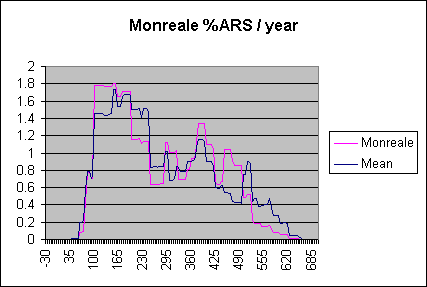
ARS supply per year at Monreale with mean
Research groups
| Name | Type | Parent Unit |
|---|---|---|
| Material Cultures Research Group | Group | Faculty of Arts |
Publications
Journal articles
The Vicchio stele and Poggio Colla (2024)
Perkins, P. and Warden, P. G.
Studi Etruschi, LXXXVII
Jean Gran-Aymerich, Les vases de bucchero: le monde étrusque entre orient et occident (Bibliotheca archaeologica 55). Rome: «L'Erma» di Bretschneider, 2017. pp. 287; 392 pp. of plates; illus., maps. 1 CD-ROM. isbn9788891308177. €450.00. (Review) (2020-11)
Perkins, Phil
Journal of Roman Studies, 110 (pp. 248-250)
The bucchero childbirth stamp on a late Orientalizing period shard from Poggio Colla (2012-12)
Perkins, Phil
Etruscan Studies, 15(2) (pp. 146-201)
Excavations at Le Mura di Santo Stefano, Anguillara Sabazia (2009-11)
Van de Noort, Robert; Whitehouse, David; Becker, Marshall; Blagg, Thomas; Burnett, Douglas; Caruso, Ida; Claridge, Amanda; Clark, Gill; Costantini, Loredana; Costantini, Lorenzo; Hall Burke, Belinda; Lyttelton, Margaret; Napolitani, Gilberto; Patterson, Helen; Perkins, Philip; Rovelli, Alessia and Sutherland, Sheila
Papers of the British School at Rome, 77(2009) (pp. 159-223)
The Villa Pigneto Sacchetti excavation: a new interpretation (2009)
Perkins, Phil and Schafer, Sally
Papers of the British School at Rome, 77(2009) (pp. 273-290)
Authored books
Etruscan Bucchero in the British Museum (2007-09)
Perkins, Philip
British Museum Research Publication
ISBN : 861591658 | Publisher : The British Museum Press | Published : London, UK
Etruscan Settlement, Society and Material Culture in Central Coastal Etruria (1999-07-26)
Perkins, Phil
British Archaeological Reports International Series
ISBN : 9781841711058 | Publisher : J. and E. Hedges | Published : Oxford
Book chapters
The bucchero from Poggio Colla (2022)
Perkins, Phil
In: Gaucci, Andrea and Cappuccini, Luca eds. Officine e artigianato ceramic nei siti etruschi dell’Appennino tosco-emiliano tra VII e IV sec. a.C.. Instituto Nazionale di Studi Etruschi ed Italici (pp. 363-383)
ISBN : 978-99-7689-339-1 | Publisher : “L’Erma” di Bretschneider | Published : Rome
The Etruscan pithos revolution (2021-09-28)
Perkins, Phil
In: Gleba, Margarita; Marín-Aguilera, Beatriz and Dimova, Bela eds. Making cities: Economies of production and urbanization in Mediterranean Europe, 1000–500 BC. McDonald Institute Conversations (pp. 231-258)
ISBN : 9781913344061 | Publisher : McDonald Institute for Archaeological Research | Published : Cambridge, UK
Ricerca e scavi a Albagino (2017-2019) (2020-12)
Perkins, Phil; Nocentini, Alessandro and Warden, P. Gregory
In: Arbeid, Barbara and Pessina, Andrea eds. Tutela & Restauro 2016 . 2019. Notiziario della Soprintendenza archeologia belle arti e paesaggio per la città metropolitana di Firenze e le province di Pistoia e Prato (pp. 414-416)
ISBN : 978-88-9285-024-8 | Publisher : All'Insegna del Giglio | Published : Sesto Fiorentino
DNA and Etruscan identity (2017-09-07)
Perkins, Phil
In: Naso, Alessandro ed. Etruscology (pp. 109-118)
ISBN : 978-1-934078-49-5 | Publisher : De Gruyter | Published : Berlin
The landscape and environment of Etruria (2017-09-07)
Perkins, Phil
In: Naso, Alessandro ed. Etruscology (pp. 1239-1250)
ISBN : 978-1-934078-49-5 | Publisher : De Gruyter | Published : Berlin
Cosa and the Ager Cosanus (2016-03)
Fentress, Elizabeth and Perkins, Phil
In: Cooley, Alison E. ed. A Companion to Roman Italy (pp. 378-400)
ISBN : 978-1-4443-3926-0 | Publisher : Wiley-Blackwell | Published : Chichester
Bucchero in context (2016-02)
Perkins, Philip
In: Bell, Sinclair and Carpino, Alexandra A. eds. A Companion to the Etruscans (pp. 224-236)
ISBN : 978-1-118-35274-8 | Publisher : Wiley-Blackwell | Published : Chichester
Processes of urban development in northern and central Etruria in the Orientalizing and Archaic periods (2014-05-31)
Perkins, Phil
In: Robinson, Elizabeth C. ed. Papers on Italian urbanism in the first Millennium B.C.. Journal of Roman Archaeology supplementary Series (97) (pp. 62-80)
ISBN : 978-0-9913730-1-7 | Publisher : Journal of Roman Archaeology | Published : Portsmouth, Rhode Island
Oinochoe di bucchero, tipo B di Batignani, decorata con un fregio di sfingi e volatile modellato sul coperchio (2014-01-01)
Perkins, Phil
In: Bruschetti, Paolo; Giulierini, Paolo; Gialluca, Bruno; Reynolds, Suzanne and Swaddling, Judith eds. Seduzione Etrusca: Dai segreti di Holkham Hall alle meraviglie del British Museum (pp. 417-418)
ISBN : 978-8857223315 | Publisher : Skira | Published : Milan
Oinochoe di bucchero decorate con un fregio di volatili, tipo A di Batignani (2014-01-01)
Perkins, Phil
In: Bruschetti, Paolo; Giulierini, Paolo; Gialluca, Bruno; Reynolds, Suzanne and Swaddling, Judith eds. Seduzione Etrusca: Dai segreti di Holkham Hall alle meraviglie del British Museum (pp. 418-419)
ISBN : 978-8857223315 | Publisher : Skira | Published : Milan
Fantastic animal stamps on bucchero from Poggio Colla (2012-12)
Perkins, Phil
In: Biella, Maria Cristina; Giovanelli, Enrico and Perego, Lucio Giuseppe eds. Il Bestiario Fantastico di età Orientalizzante nella Penisola Italiana. Quaderni di Aristonothos (pp. 171-188)
ISBN : 9788864580692 | Publisher : Tangram Edizioni Scientifiche | Published : Trento
Production and commercialization of Etruscan wine in the Albegna Valley (2012-09)
Perkins, Philip
In: Zifferero, Andrea; Ciacci, Andrea and Rendini, Paola eds. Archeologia della vite e del vino in Toscana e nel Lazio. dalle tecniche dell’indagine archeologica alle prospettive della biologia molecolare (pp. 413-416)
ISBN : 978-88-7814-538-2 | Publisher : All’Insegna dell’ Giglio | Published : Florence
The Etruscans, their DNA and the Orient (2011-11)
Perkins, P.
In: Duistermaat, Kim and Regulski, Ilona eds. Intercultural Contacts in the Ancient Mediterranean: Proceedings of the International Conference at the Netherlands-Flemish Institute in Cairo, 25th to 29th October 2008. Orientalia Lovaniensia Analecta (202) (pp. 171-180)
ISBN : 9789042924512 | Publisher : Peeters | Published : Leuven
The cultural and political landscape of the Ager Caletranus, North-West of Vulci (2010-10)
Perkins, Phil
In: Fontaine, P. ed. L'Etrurie et l'ombrie avant Rome: Cité et Territoire. Institut Historique Belge de Rome Artes (1) (pp. 103-121)
ISBN : 978-90-74461-61-0 | Publisher : Institut Historique Belge de Rome | Published : Brussels, Belgium / Romr, Italy
DNA and Etruscan Identity (2009-11)
Perkins, Philip
In: Perkins, Philip and Swaddling, Judith eds. Etruscan by Definition: Papers in Honour of Sybille Haynes. The British Museum Research Publications (173) (pp. 95-111)
ISBN : 978-0-86159-173-2 | Publisher : The British Museum Press | Published : London, UK
Sicily (2009-11)
Perkins, Phil
In: Gagarin, Michael ed. The Oxford Encyclopedia of Ancient Greece and Rome
ISBN : 9780195170726 | Publisher : Oxford University Press | Published : New York, USA
Aliud in Sicilia? Cultural development in Rome's first Province (2007-04)
Perkins, Philip
In: Van Dommelen, P. and Terranato, N. eds. Articulating Local Cultures: Power and identity under the expanding Roman Republic. International Roman Archaeology Conference Series (63) (pp. 33-53)
ISBN : 1 887829 63 6 | Publisher : Journal of Roman Archaeology | Published : Rhode Island, USA
Who lived in the Etruscan Albegna Valley? (2005)
Perkins, Phil
In: Attema, Peter; Nijboer, Albert and Zifferero, Andrea eds. Papers in Italian Archaeology VI: Communities and settlements from the Neolithic to the Early Medieval Period. British Archaeological Reports Series (1452 (1)) (pp. 109-117)
ISBN : 1841718890 | Publisher : Archaeopress | Published : Oxford
Accounting for ARS: fineware and sites in Sicily and Africa (2004)
Fentress, Elizabeth; Fontana, Sergio; Hitchner, R. Bruce and Perkins, Philip
In: Alcock, Susan E. and Cherry, John F. eds. Side-by-side survey: comparative regional studies in the Mediterranean world (pp. 147-162)
ISBN : 1842170961 | Publisher : Oxbow Books | Published : Oxford, UK
Edited books
Etruscan by Definition: The Cultural, Regional and Personal Identity of the Etruscans (2009-11)
Swaddling, Judith and Perkins, Philip eds.
The British Museum Research Publications
ISBN : 978-0-86159-173-2 | Publisher : The British Museum Press | Published : London

